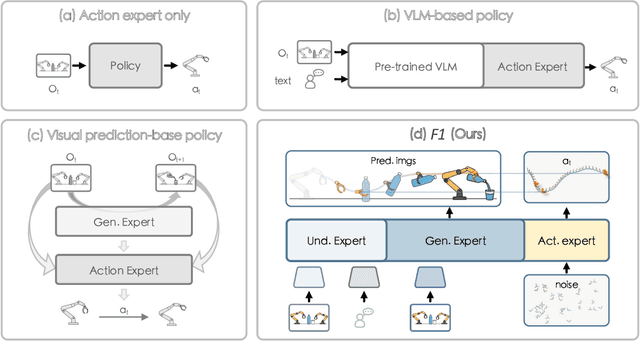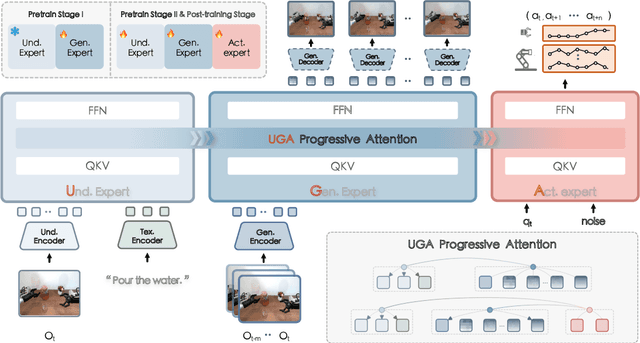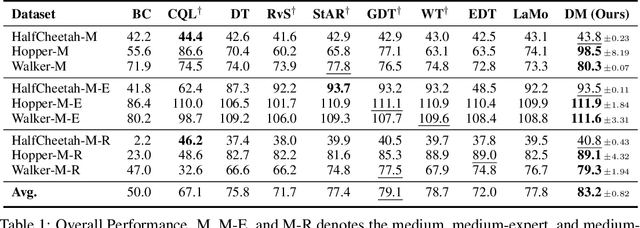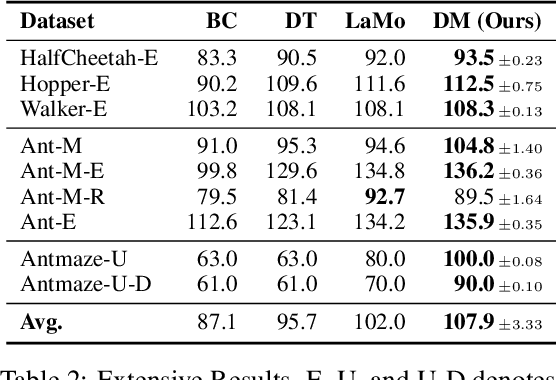Qi Lv
F1: A Vision-Language-Action Model Bridging Understanding and Generation to Actions
Sep 09, 2025



Abstract:Executing language-conditioned tasks in dynamic visual environments remains a central challenge in embodied AI. Existing Vision-Language-Action (VLA) models predominantly adopt reactive state-to-action mappings, often leading to short-sighted behaviors and poor robustness in dynamic scenes. In this paper, we introduce F1, a pretrained VLA framework which integrates the visual foresight generation into decision-making pipeline. F1 adopts a Mixture-of-Transformer architecture with dedicated modules for perception, foresight generation, and control, thereby bridging understanding, generation, and actions. At its core, F1 employs a next-scale prediction mechanism to synthesize goal-conditioned visual foresight as explicit planning targets. By forecasting plausible future visual states, F1 reformulates action generation as a foresight-guided inverse dynamics problem, enabling actions that implicitly achieve visual goals. To endow F1 with robust and generalizable capabilities, we propose a three-stage training recipe on an extensive dataset comprising over 330k trajectories across 136 diverse tasks. This training scheme enhances modular reasoning and equips the model with transferable visual foresight, which is critical for complex and dynamic environments. Extensive evaluations on real-world tasks and simulation benchmarks demonstrate F1 consistently outperforms existing approaches, achieving substantial gains in both task success rate and generalization ability.
EmbodiedOneVision: Interleaved Vision-Text-Action Pretraining for General Robot Control
Aug 28, 2025Abstract:The human ability to seamlessly perform multimodal reasoning and physical interaction in the open world is a core goal for general-purpose embodied intelligent systems. Recent vision-language-action (VLA) models, which are co-trained on large-scale robot and visual-text data, have demonstrated notable progress in general robot control. However, they still fail to achieve human-level flexibility in interleaved reasoning and interaction. In this work, introduce EO-Robotics, consists of EO-1 model and EO-Data1.5M dataset. EO-1 is a unified embodied foundation model that achieves superior performance in multimodal embodied reasoning and robot control through interleaved vision-text-action pre-training. The development of EO-1 is based on two key pillars: (i) a unified architecture that processes multimodal inputs indiscriminately (image, text, video, and action), and (ii) a massive, high-quality multimodal embodied reasoning dataset, EO-Data1.5M, which contains over 1.5 million samples with emphasis on interleaved vision-text-action comprehension. EO-1 is trained through synergies between auto-regressive decoding and flow matching denoising on EO-Data1.5M, enabling seamless robot action generation and multimodal embodied reasoning. Extensive experiments demonstrate the effectiveness of interleaved vision-text-action learning for open-world understanding and generalization, validated through a variety of long-horizon, dexterous manipulation tasks across multiple embodiments. This paper details the architecture of EO-1, the data construction strategy of EO-Data1.5M, and the training methodology, offering valuable insights for developing advanced embodied foundation models.
STAR: Learning Diverse Robot Skill Abstractions through Rotation-Augmented Vector Quantization
Jun 04, 2025



Abstract:Transforming complex actions into discrete skill abstractions has demonstrated strong potential for robotic manipulation. Existing approaches mainly leverage latent variable models, e.g., VQ-VAE, to learn skill abstractions through learned vectors (codebooks), while they suffer from codebook collapse and modeling the causal relationship between learned skills. To address these limitations, we present \textbf{S}kill \textbf{T}raining with \textbf{A}ugmented \textbf{R}otation (\textbf{STAR}), a framework that advances both skill learning and composition to complete complex behaviors. Specifically, to prevent codebook collapse, we devise rotation-augmented residual skill quantization (RaRSQ). It encodes relative angles between encoder outputs into the gradient flow by rotation-based gradient mechanism. Points within the same skill code are forced to be either pushed apart or pulled closer together depending on gradient directions. Further, to capture the causal relationship between skills, we present causal skill transformer (CST) which explicitly models dependencies between skill representations through an autoregressive mechanism for coherent action generation. Extensive experiments demonstrate the superiority of STAR on both LIBERO benchmark and realworld tasks, with around 12\% improvement over the baselines.
* Accepted by ICML 2025 Spotlight
Hume: Introducing System-2 Thinking in Visual-Language-Action Model
May 29, 2025



Abstract:Humans practice slow thinking before performing actual actions when handling complex tasks in the physical world. This thinking paradigm, recently, has achieved remarkable advancement in boosting Large Language Models (LLMs) to solve complex tasks in digital domains. However, the potential of slow thinking remains largely unexplored for robotic foundation models interacting with the physical world. In this work, we propose Hume: a dual-system Vision-Language-Action (VLA) model with value-guided System-2 thinking and cascaded action denoising, exploring human-like thinking capabilities of Vision-Language-Action models for dexterous robot control. System 2 of Hume implements value-Guided thinking by extending a Vision-Language-Action Model backbone with a novel value-query head to estimate the state-action value of predicted actions. The value-guided thinking is conducted by repeat sampling multiple action candidates and selecting one according to state-action value. System 1 of Hume is a lightweight reactive visuomotor policy that takes System 2 selected action and performs cascaded action denoising for dexterous robot control. At deployment time, System 2 performs value-guided thinking at a low frequency while System 1 asynchronously receives the System 2 selected action candidate and predicts fluid actions in real time. We show that Hume outperforms the existing state-of-the-art Vision-Language-Action models across multiple simulation benchmark and real-robot deployments.
Few-Shot Vision-Language Action-Incremental Policy Learning
Apr 22, 2025Abstract:Recently, Transformer-based robotic manipulation methods utilize multi-view spatial representations and language instructions to learn robot motion trajectories by leveraging numerous robot demonstrations. However, the collection of robot data is extremely challenging, and existing methods lack the capability for continuous learning on new tasks with only a few demonstrations. In this paper, we formulate these challenges as the Few-Shot Action-Incremental Learning (FSAIL) task, and accordingly design a Task-prOmpt graPh evolutIon poliCy (TOPIC) to address these issues. Specifically, to address the data scarcity issue in robotic imitation learning, TOPIC learns Task-Specific Prompts (TSP) through the deep interaction of multi-modal information within few-shot demonstrations, thereby effectively extracting the task-specific discriminative information. On the other hand, to enhance the capability for continual learning on new tasks and mitigate the issue of catastrophic forgetting, TOPIC adopts a Continuous Evolution Strategy (CES). CES leverages the intrinsic relationships between tasks to construct a task relation graph, which effectively facilitates the adaptation of new tasks by reusing skills learned from previous tasks. TOPIC pioneers few-shot continual learning in the robotic manipulation task, and extensive experimental results demonstrate that TOPIC outperforms state-of-the-art baselines by over 26$\%$ in success rate, significantly enhancing the continual learning capabilities of existing Transformer-based policies.
Spatial-Temporal Graph Diffusion Policy with Kinematic Modeling for Bimanual Robotic Manipulation
Mar 13, 2025



Abstract:Despite the significant success of imitation learning in robotic manipulation, its application to bimanual tasks remains highly challenging. Existing approaches mainly learn a policy to predict a distant next-best end-effector pose (NBP) and then compute the corresponding joint rotation angles for motion using inverse kinematics. However, they suffer from two important issues: (1) rarely considering the physical robotic structure, which may cause self-collisions or interferences, and (2) overlooking the kinematics constraint, which may result in the predicted poses not conforming to the actual limitations of the robot joints. In this paper, we propose Kinematics enhanced Spatial-TemporAl gRaph Diffuser (KStar Diffuser). Specifically, (1) to incorporate the physical robot structure information into action prediction, KStar Diffuser maintains a dynamic spatial-temporal graph according to the physical bimanual joint motions at continuous timesteps. This dynamic graph serves as the robot-structure condition for denoising the actions; (2) to make the NBP learning objective consistent with kinematics, we introduce the differentiable kinematics to provide the reference for optimizing KStar Diffuser. This module regularizes the policy to predict more reliable and kinematics-aware next end-effector poses. Experimental results show that our method effectively leverages the physical structural information and generates kinematics-aware actions in both simulation and real-world
EPD: Long-term Memory Extraction, Context-awared Planning and Multi-iteration Decision @ EgoPlan Challenge ICML 2024
Jul 28, 2024



Abstract:In this technical report, we present our solution for the EgoPlan Challenge in ICML 2024. To address the real-world egocentric task planning problem, we introduce a novel planning framework which comprises three stages: long-term memory Extraction, context-awared Planning, and multi-iteration Decision, named EPD. Given the task goal, task progress, and current observation, the extraction model first extracts task-relevant memory information from the progress video, transforming the complex long video into summarized memory information. The planning model then combines the context of the memory information with fine-grained visual information from the current observation to predict the next action. Finally, through multi-iteration decision-making, the decision model comprehensively understands the task situation and current state to make the most realistic planning decision. On the EgoPlan-Test set, EPD achieves a planning accuracy of 53.85% over 1,584 egocentric task planning questions. We have made all codes available at https://github.com/Kkskkkskr/EPD .
Decision Mamba: A Multi-Grained State Space Model with Self-Evolution Regularization for Offline RL
Jun 08, 2024



Abstract:While the conditional sequence modeling with the transformer architecture has demonstrated its effectiveness in dealing with offline reinforcement learning (RL) tasks, it is struggle to handle out-of-distribution states and actions. Existing work attempts to address this issue by data augmentation with the learned policy or adding extra constraints with the value-based RL algorithm. However, these studies still fail to overcome the following challenges: (1) insufficiently utilizing the historical temporal information among inter-steps, (2) overlooking the local intrastep relationships among states, actions and return-to-gos (RTGs), (3) overfitting suboptimal trajectories with noisy labels. To address these challenges, we propose Decision Mamba (DM), a novel multi-grained state space model (SSM) with a self-evolving policy learning strategy. DM explicitly models the historical hidden state to extract the temporal information by using the mamba architecture. To capture the relationship among state-action-RTG triplets, a fine-grained SSM module is designed and integrated into the original coarse-grained SSM in mamba, resulting in a novel mamba architecture tailored for offline RL. Finally, to mitigate the overfitting issue on noisy trajectories, a self-evolving policy is proposed by using progressive regularization. The policy evolves by using its own past knowledge to refine the suboptimal actions, thus enhancing its robustness on noisy demonstrations. Extensive experiments on various tasks show that DM outperforms other baselines substantially.
RoboMP$^2$: A Robotic Multimodal Perception-Planning Framework with Multimodal Large Language Models
Apr 07, 2024Abstract:Multimodal Large Language Models (MLLMs) have shown impressive reasoning abilities and general intelligence in various domains. It inspires researchers to train end-to-end MLLMs or utilize large models to generate policies with human-selected prompts for embodied agents. However, these methods exhibit limited generalization capabilities on unseen tasks or scenarios, and overlook the multimodal environment information which is critical for robots to make decisions. In this paper, we introduce a novel Robotic Multimodal Perception-Planning (RoboMP$^2$) framework for robotic manipulation which consists of a Goal-Conditioned Multimodal Preceptor (GCMP) and a Retrieval-Augmented Multimodal Planner (RAMP). Specially, GCMP captures environment states by employing a tailored MLLMs for embodied agents with the abilities of semantic reasoning and localization. RAMP utilizes coarse-to-fine retrieval method to find the $k$ most-relevant policies as in-context demonstrations to enhance the planner. Extensive experiments demonstrate the superiority of RoboMP$^2$ on both VIMA benchmark and real-world tasks, with around 10% improvement over the baselines.
RSpell: Retrieval-augmented Framework for Domain Adaptive Chinese Spelling Check
Aug 16, 2023



Abstract:Chinese Spelling Check (CSC) refers to the detection and correction of spelling errors in Chinese texts. In practical application scenarios, it is important to make CSC models have the ability to correct errors across different domains. In this paper, we propose a retrieval-augmented spelling check framework called RSpell, which searches corresponding domain terms and incorporates them into CSC models. Specifically, we employ pinyin fuzzy matching to search for terms, which are combined with the input and fed into the CSC model. Then, we introduce an adaptive process control mechanism to dynamically adjust the impact of external knowledge on the model. Additionally, we develop an iterative strategy for the RSpell framework to enhance reasoning capabilities. We conducted experiments on CSC datasets in three domains: law, medicine, and official document writing. The results demonstrate that RSpell achieves state-of-the-art performance in both zero-shot and fine-tuning scenarios, demonstrating the effectiveness of the retrieval-augmented CSC framework. Our code is available at https://github.com/47777777/Rspell.
 Add to Chrome
Add to Chrome Add to Firefox
Add to Firefox Add to Edge
Add to Edge